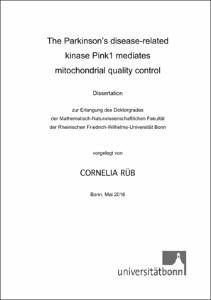The Parkinson’s disease-related kinase Pink1 mediates mitochondrial quality control

The Parkinson’s disease-related kinase Pink1 mediates mitochondrial quality control

| dc.contributor.advisor | Voos, Wolfgang | |
| dc.contributor.author | Rüb, Cornelia | |
| dc.date.accessioned | 2020-04-22T21:58:01Z | |
| dc.date.available | 2020-04-22T21:58:01Z | |
| dc.date.issued | 29.08.2016 | |
| dc.identifier.uri | https://hdl.handle.net/20.500.11811/6873 | |
| dc.description.abstract | Mitochondrial dysfunction is a common feature of many neurodegenerative diseases, in particular Parkinson’s disease (PD). Mutations in the genes encoding the mitochondrial kinase Pink1 and the cytosolic E3 ubiquitin ligase Parkin have been associated with familial cases of PD. In healthy cells, the Pink1/Parkin system functions as sensor of mitochondrial damage in an organellar quality control system. High levels of Pink1 accumulate at the surface of damaged mitochondria to recruit and activate Parkin. In turn, Parkin initiates a signaling reaction eventually resulting in the autophagic removal of the organelle, a process termed mitophagy. In my thesis, I analyzed mitochondrial and cellular stress conditions, resulting in an increase in Pink1 protein levels. I was able to demonstrate that the accumulation of Pink1 was not strictly correlated with a depolarization of the mitochondrial inner membrane potential (Δψ) or with changes in mitochondrial ATP levels. Both cellular and mitochondrial protein turnover rates were also not affected by changes in the mitochondrial membrane potential. In contrast, inhibition of cellular transcription or translation reactions completely blocked Pink1 accumulation. Characterization of mRNA levels indicated that the increase of Pink1 amounts after acute mitochondrial perturbations was based on a transcriptional induction reaction. My results demonstrate that the mitochondrial quality control process mediated by the Pink1-Parkin system is based on a transcriptional response triggered independently of reductions in Dy. This yet unknown signaling pathway may involve the transcriptional regulator NFκB. Another factor prominently involved in PD is the aggregation-prone cytosolic protein α-synuclein, which is the major constituent of Lewy body inclusions. Although α-synuclein has previously been proposed to exert mitochondrial damage and localize to mitochondria, its submitochondrial localization remained controversial. In my thesis, I was able to demonstrate that α synuclein is not imported into mitochondria but apparently associates with the outer mitochondrial membrane in a Δψ-dependent manner. | en |
| dc.language.iso | eng | |
| dc.rights | In Copyright | |
| dc.rights.uri | http://rightsstatements.org/vocab/InC/1.0/ | |
| dc.subject | Mitochondrien | |
| dc.subject | Parkinson | |
| dc.subject | Pink1 | |
| dc.subject | Mitophagie | |
| dc.subject | Alpha-synuclein | |
| dc.subject | Mitochondria | |
| dc.subject | Parkinson's disease | |
| dc.subject | Mitophagy | |
| dc.subject.ddc | 570 Biowissenschaften, Biologie | |
| dc.subject.ddc | 610 Medizin, Gesundheit | |
| dc.title | The Parkinson’s disease-related kinase Pink1 mediates mitochondrial quality control | |
| dc.type | Dissertation oder Habilitation | |
| dc.publisher.name | Universitäts- und Landesbibliothek Bonn | |
| dc.publisher.location | Bonn | |
| dc.rights.accessRights | openAccess | |
| dc.identifier.urn | https://nbn-resolving.org/urn:nbn:de:hbz:5n-44606 | |
| ulbbn.pubtype | Erstveröffentlichung | |
| ulbbnediss.affiliation.name | Rheinische Friedrich-Wilhelms-Universität Bonn | |
| ulbbnediss.affiliation.location | Bonn | |
| ulbbnediss.thesis.level | Dissertation | |
| ulbbnediss.dissID | 4460 | |
| ulbbnediss.date.accepted | 08.08.2016 | |
| ulbbnediss.institute | Medizinische Fakultät / Institute : Institut für Biochemie und Molekularbiologie (IBMB) | |
| ulbbnediss.fakultaet | Mathematisch-Naturwissenschaftliche Fakultät | |
| dc.contributor.coReferee | Höhfeld, Jörg |
Dateien zu dieser Ressource
Das Dokument erscheint in:
-
E-Dissertationen (4337)




